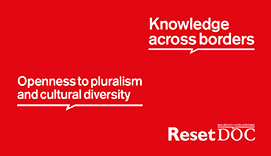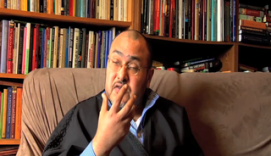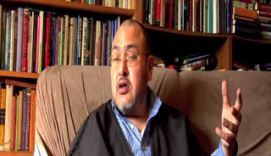Interview: Nina zu Fürstenberg
Film: Anna Fanuele
Full transcript of the interview
If you look to the broader region of the Middle East, what you observe is a large number of wars. Right now, a war is going on in Syria, another civil war is going on in Afghanistan, last year there was a war in Libya, before that there was Iraq and Iraq is not finished yet, there was Lebanon…So it looks like the region of the Middle East suffers from many different civil wars, suffers from a lot violent conflicts. How true is that perception when we are trying to have a broader comparative look at the world, not just at the region of the MENA? It turns out that it does produce indeed quite a lot of conflicts. If one looks at the major civil wars worldwide since 1945, the Middle East accounts for about 17% of conflicts, which is quite an important percentage.
If one looks at the region of the Middle East and North Africa, one would observe a very large number of conflicts taking place: there is of course the civil war taking place right now in Syria, the war that has been taking place for a number of years now in Afghanistan, last year and the previous years we had the war in Lybia, the war in Iraq, in the past the war Lebanon…there is plenty of conflict in the region. So is it true that the Middle East is a region characterized by conflict? What is the picture if we actually take a broader sweep into the world and embed the region of the Middle East and North Africa into the entire global picture. It turns out that when you look at all the major wars that started across the globe from 1945 on, we have about 160 major civil wars, and the Middle East and North Africa account for about 17% of those wars, a quite important percentage. It is not enormous, but certainly the region seems to produce more conflict than its actual population and size, but not by too much.
However, when one disaggregates by time we find some interesting elements here. Most of those conflicts in the Middle East really start in the Seventies and really peak in the Nineties, and in that respect the Middle East and North Africa are not very different from the rest of the world, because the Seventies and the Nineties are the decades that produced the most new civil wars. However, when one takes a look at the period that started with the end of the cold war, what we see then is the differentiation of the region from the rest of the world. Whereas in the rest of the world there is a clear and very steep decline of civil wars after the end of the cold war, that is not the case with the Middle East and North Africa. We see, in fact, more conflicts erupting after the end of the cold war, we see the trend continues and we don’t see the region moving in the same direction [as the rest of the world].
This is really a puzzle: why is it that the Middle East and the North African region behave in a way that is so different from the rest? There are number of possibilities, a number of reasons for that differentiation, but I think that what is particularly important to take into account are two elements:
The first one is that in terms of structural international dynamics, the MENA region exhibits characteristics similar to those of the globe during the cold war. There is a lot of superpower interest: the United States is extremely committed and present in the area – in fact two of the major civil wars are associated with direct US interventions, Iraq and Afghanistan. We also observe that other major powers, such as Russia for example, are present in the area. We see a lot influx of weapons and financial support stated and rebels. We see a lot of international involvement, both regional and much more global. This is a characteristic of the cold war, which has ended in most other places but has not in the Middle East, for some reasons that have to do with some peculiar elements of the region, primarily the presence of energy sources but also the continuing Israel-Palestine conflict.
The second element that makes the region specific and accounts with this continuation of conflict is the emergence of a revolutionary ideology. With the decline of Marxism, with the end of the Soviet Union the main revolutionary ideology in form of transnational organization that dominated and motivated a lot of insurgents across the world disappeared. As a result of that, a lot of the movements that were inspired by this project of socialist transformation of society disappeared as well; they lost their raison d’être.
This is not the case with the wider Islamic world, in which a strong counterhegemonic ideology developed. And this is the ideology of jihadism, or salafism: the idea that societies should be reformed in an Islamic way and should shun the West and its ways. This ideology – even though not by any means dominant in Muslim societies – attracted a large numbers of followers, generated a lot of activity, is at the source of a transnational movement – that is why we see a lot of foreign fighters floating to a lot of these local conflicts – and provided the link between those transnational revolutionary movements, activists and ideas on the one hand, and much more local and parochial concerns of the individuals who join the fighting at a local level and who may be motivated by sectarian, ethnic or very local kinds of grievances.
The result of those two factors – the international structural dynamics on the one hand and the revolutionary element in the form of jihadi Islamism – I think are the factors that explain why the region has become so atypical compared to the rest of the world, why whereas in the rest of the world civil wars have been declining they have been booming in the Middle East and why we are likely to see a continuation of those conflicts for the short and near future at least.
I think that this description and this very rough analysis give us an incentive to try to think more systematically about the factors that keep conflicts continuing in that region – both the international factors and the ideological factors –, as the basis towards which we can think about how to productively start developing ideas about at least mitigating the effects of the conflicts if not ending them. Certainly, it seems that, in order for us to think productively about the region, about this pike of conflicts, we have to take into account factors that – even though not specific to the region; they are both global and much more general – they are also very closely related to both the Middle East and Islam, and therefore differentiate that region from the rest of the world.
My proposal, my call is to try and think in ways that are both very broadly comparative – because that gives us a sense of what is specific about particular areas of the world – but at the same time incorporate into our analysis those elements that point to the specificities of those particular hotspots and places. And by combining those general comparative features on the one hand with very connected and local features on the other hand, I think we will be able to understand and eventually propose intervention ways that may be better adapted to that reality.







